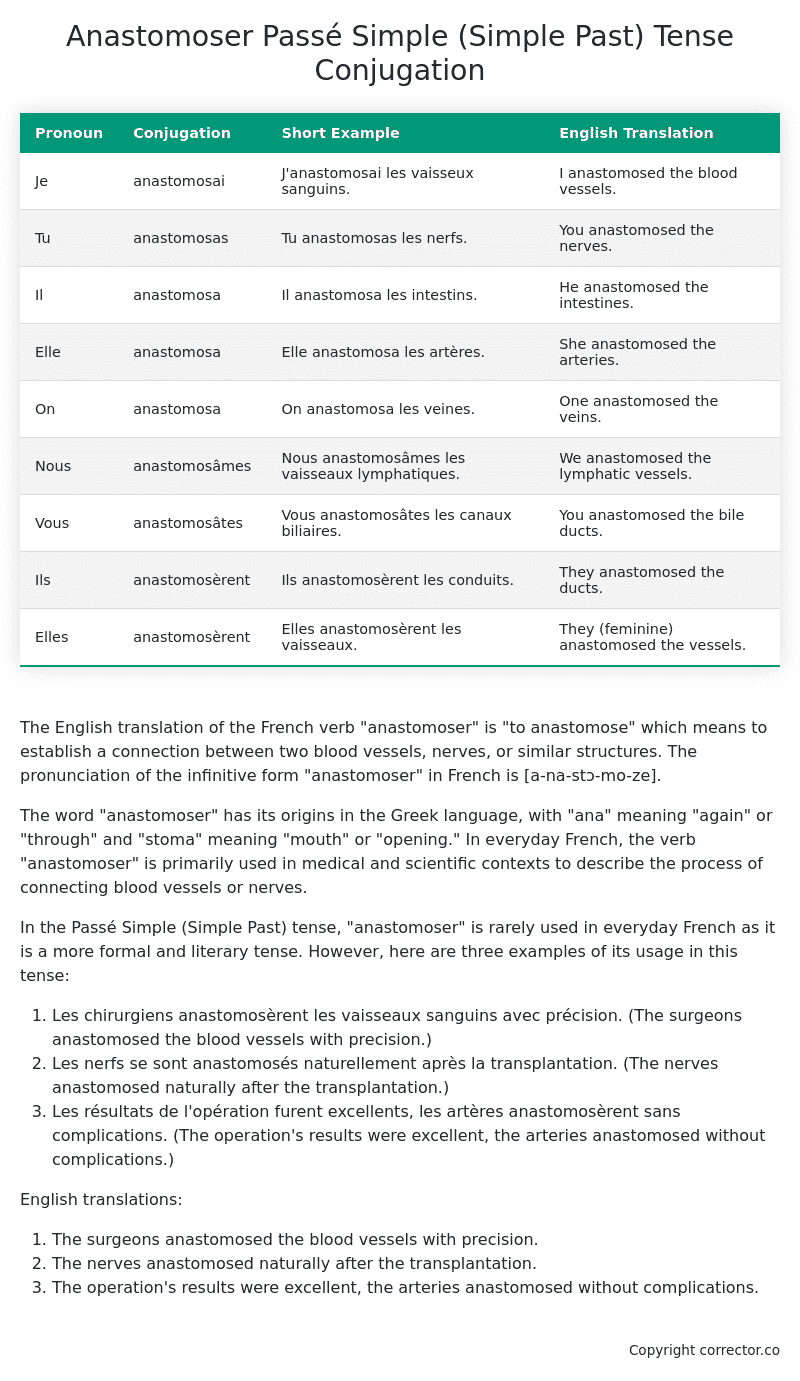Passé Simple (Simple Past) Tense Conjugation of the French Verb anastomoser
Introduction to the verb anastomoser
The English translation of the French verb “anastomoser” is “to anastomose” which means to establish a connection between two blood vessels, nerves, or similar structures. The pronunciation of the infinitive form “anastomoser” in French is [a-na-stɔ-mo-ze].
The word “anastomoser” has its origins in the Greek language, with “ana” meaning “again” or “through” and “stoma” meaning “mouth” or “opening.” In everyday French, the verb “anastomoser” is primarily used in medical and scientific contexts to describe the process of connecting blood vessels or nerves.
In the Passé Simple (Simple Past) tense, “anastomoser” is rarely used in everyday French as it is a more formal and literary tense. However, here are three examples of its usage in this tense:
- Les chirurgiens anastomosèrent les vaisseaux sanguins avec précision. (The surgeons anastomosed the blood vessels with precision.)
- Les nerfs se sont anastomosés naturellement après la transplantation. (The nerves anastomosed naturally after the transplantation.)
- Les résultats de l’opération furent excellents, les artères anastomosèrent sans complications. (The operation’s results were excellent, the arteries anastomosed without complications.)
English translations:
- The surgeons anastomosed the blood vessels with precision.
- The nerves anastomosed naturally after the transplantation.
- The operation’s results were excellent, the arteries anastomosed without complications.
Table of the Passé Simple (Simple Past) Tense Conjugation of anastomoser
| Pronoun | Conjugation | Short Example | English Translation |
|---|---|---|---|
| Je | anastomosai | J’anastomosai les vaisseux sanguins. | I anastomosed the blood vessels. |
| Tu | anastomosas | Tu anastomosas les nerfs. | You anastomosed the nerves. |
| Il | anastomosa | Il anastomosa les intestins. | He anastomosed the intestines. |
| Elle | anastomosa | Elle anastomosa les artères. | She anastomosed the arteries. |
| On | anastomosa | On anastomosa les veines. | One anastomosed the veins. |
| Nous | anastomosâmes | Nous anastomosâmes les vaisseaux lymphatiques. | We anastomosed the lymphatic vessels. |
| Vous | anastomosâtes | Vous anastomosâtes les canaux biliaires. | You anastomosed the bile ducts. |
| Ils | anastomosèrent | Ils anastomosèrent les conduits. | They anastomosed the ducts. |
| Elles | anastomosèrent | Elles anastomosèrent les vaisseaux. | They (feminine) anastomosed the vessels. |
Other Conjugations for Anastomoser.
Le Present (Present Tense) Conjugation of the French Verb anastomoser
Imparfait (Imperfect) Tense Conjugation of the French Verb anastomoser
Passé Simple (Simple Past) Tense Conjugation of the French Verb anastomoser (You’re reading it right now!)
Passé Composé (Present Perfect) Tense Conjugation of the French Verb anastomoser
Futur Simple (Simple Future) Tense Conjugation of the French Verb anastomoser
Futur Proche (Near Future) Tense Conjugation of the French Verb anastomoser
Plus-que-parfait (Pluperfect) Tense Conjugation of the French Verb anastomoser
Passé Antérieur (Past Anterior) Tense Conjugation of the French Verb anastomoser
Futur Antérieur (Future Anterior) Tense Conjugation of the French Verb anastomoser
Subjonctif Présent (Subjunctive Present) Tense Conjugation of the French Verb anastomoser
Subjonctif Passé (Subjunctive Past) Tense Conjugation of the French Verb anastomoser
Subjonctif Imparfait (Subjunctive Imperfect) Tense Conjugation of the French Verb anastomoser
Conditionnel Présent (Conditional Present) Tense Conjugation of the French Verb anastomoser
Conditionnel Passé (Conditional Past) Tense Conjugation of the French Verb anastomoser
Conditionnel Passé II (Conditional Past II) Tense Conjugation of the French Verb anastomoser
L’impératif Présent (Imperative Present) Tense Conjugation of the French Verb anastomoser
L’impératif Passé (Imperative Past) Tense Conjugation of the French Verb anastomoser
L’infinitif Présent (Infinitive Present) Tense Conjugation of the French Verb anastomoser
L’infinitif Passé (Infinitive Past) Tense Conjugation of the French Verb anastomoser
Le Participe Présent (Present Participle) Tense Conjugation of the French Verb anastomoser
Le Participe Passé (Past Participle) Tense Conjugation of the French Verb anastomoser
Struggling with French verbs or the language in general? Why not use our free French Grammar Checker – no registration required!
Get a FREE Download Study Sheet of this Conjugation 🔥
Simply right click the image below, click “save image” and get your free reference for the anastomoser Passé Simple tense conjugation!

Anastomoser – About the French Passé Simple (Simple Past) Tense
Formation
Usage
Narration
Historical Context
Interactions with other tenses
Passé Composé
Imparfait
Conditional and Subjunctive
Summary
I hope you enjoyed this article on the verb anastomoser. Still in a learning mood? Check out another TOTALLY random French verb conjugation!


